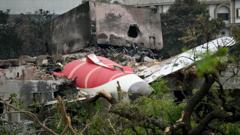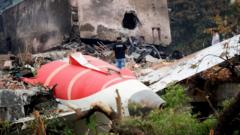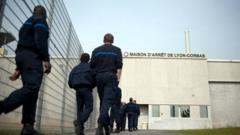The unexpected shutdown of the aircraft's fuel control switches seconds after takeoff prompts scrutiny of pilot actions and the integrity of aircraft design, leaving many questions unanswered.
**Mysterious Cut-Off Switches in Air India Flight 171 Crash Raise Questions**

**Mysterious Cut-Off Switches in Air India Flight 171 Crash Raise Questions**
New evidence from the cockpit voice recorder intensifies the enigma of the Air India Flight 171 disaster, as investigators delve into potential mechanical failures and pilot decisions.
Investigators have made a harrowing revelation regarding the tragic crash of Air India Flight 171, which resulted in the loss of 260 lives in June. Soon after takeoff, both fuel-control switches on the Boeing 787 Dreamliner abruptly shifted to the "cut-off" position, disrupting fuel flow and causing a total engine failure. This maneuver is typically reserved for after landing. Cockpit recordings reveal one pilot questioning the other about the switch, only to receive the response that he did not execute the action, intensifying the mystery as to who was responsible.
Flight 171 took to the skies only for a brief 40 seconds, reaching an altitude of 625 feet before crashing in a dense neighborhood of Ahmedabad. The ongoing investigation, involving stakeholders from Boeing, GE, and global aviation authorities, aims to uncover the reasons behind this perplexing incident. As the report notes, the fuel switches are intentionally designed to prevent accidental activation, necessitating a specific unlock motion, making their simultaneous disengagement an anomaly.
Shawn Pruchnicki, an aviation expert, emphasized the oddity of the switches being turned off in such a crucial phase of flight, raising doubts about possible confusion but also noting the absence of any unusual circumstances voiced by the pilots during their final moments. Former NTSB managing director Peter Goelz stated that the cockpit recordings might contain more critical information that remains undiscovered. Identifying the voices on the recordings and understanding the sequence of events leading to the switch's manipulation are vital aspects of the investigation.
Reinforcing the need for cockpit video recorders, experts highlight that the absence of visual evidence makes it challenging to determine who intervened with the fuel switches. Before embarking on the flight, both pilots had cleared breathalyzer tests and were deemed fit for duty. Investigators noted their adequate rest the day prior as well, complicating hypotheses about pilot error.
Additionally, the report cites an FAA bulletin from December 2018 raising concerns about certain Boeing fuel control switches lacking proper locking capabilities. Despite this advisory mention, no unsafe directives were enforced, and Air India did not act on the recommendations.
Questions linger about whether malfunctioning electronic systems could trigger the switches without pilot input and what implications this might bear for the reliability of Boeing's 787 model. As the investigation proceeds, the potential that fuel contamination or mechanical issues contributed to the engine failure is still under exploration, although no advisories have been issued regarding the aircraft model or its engines.
With the aircraft soon reaching a critical loss of power, investigators note the rapid deployment of the Ram Air Turbine (RAT), underscoring the severity of the systems' failures. Experts suggest the crew's frantic attempts to restore power came too late, highlighting the urgency of the situation as altitude dwindled.
In summary, while the investigation continues, the tragic events of Air India Flight 171 remain steeped in mystery, with uncertainties about both pilot actions and the aircraft's design complicating the quest for clarity in one of India's most tragic aviation incidents.





















